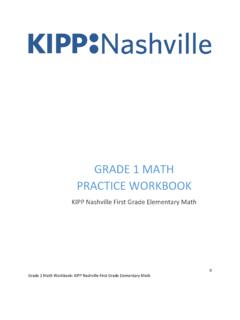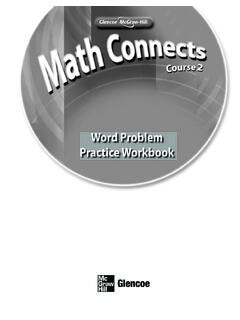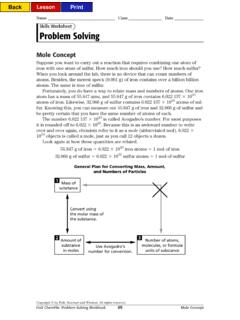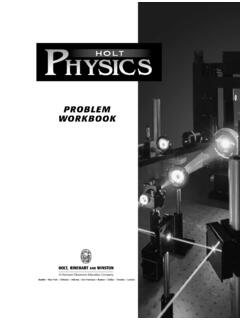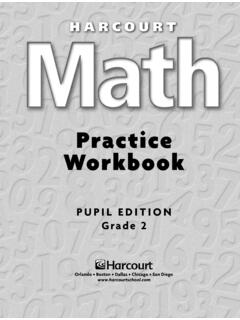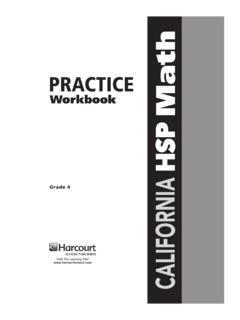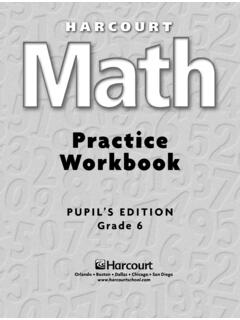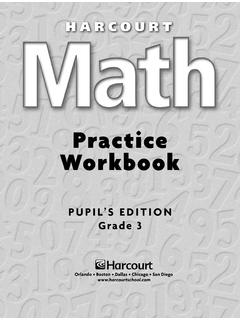Transcription of Grade 4 math Practice workbook - KIPP Nashville
1 1. Grade 4 math . Practice workbook . KIPP Nashville Elementary math 1. Adapted from Achievement First Practice Workbooks Elementary math Grade 4. Contents workbook 4. Interpret a multiplication equation as a comparison and represent verbal statements of multiplicative comparisons as multiplication equations, , interpret 35 = 5 x 7. as a statement that 35 is 5 times as many as 7, and 7 times as many as 4. Using whole numbers in the range 1-100, find all factor pairs for a given whole number, recognize that a given whole number is a multiple of each of its factors, determine whether a given whole number is a multiple of a given one-digit number, and determine whether a given whole number is prime or 9. Generate a number or shape pattern that follows a given rule. Identify apparent features of the pattern that were not explicit in the rule itself.
2 14. workbook B .. 19. Generalize place value understanding for multi-digit whole numbers. Recognize that in a multi-digit whole number less than or equal to 1,000,000, a digit in one place represents ten times what it represents in a place to its right.. 19. Read and write multi-digit whole numbers less than or equal to 1,000,000 using base-ten numerals, number names, and expanded form. Compare two multi-digit whole numbers based on the meanings of the digits in each place, using >, =, and < symbols to record the results of comparisons.. 28. Use place value understanding to round multi-digit whole numbers, less than or equal to 1,000,000 to any place.. 35. workbook C .. 40. Fluently add and subtract multi-digit whole numbers, with sums less than or equal to 1,000,000, using the standard algorithm.
3 40. workbook 43. Multiply a whole number of up to four digits by a one-digit number, and multiply two two-digit numbers, using strategies based on place value and the properties of operations and explain the calculations by using equations, rectangular arrays, and/or area models.. 43. Find whole-number quotients and remainders with up to 4-digit dividends and one-digit divisors, using strategies based on place value, the properties of operations, and/or the relationship between multiplication and division. Illustrate and explain the calculation by using equation, rectangular arrays, and/or area models.. 49. Grade 4 math Practice workbook 1. Know relative sizes of measurement units within one system of units including ft, in; km, m, cm, g; lb, oz; l, ml; hr, min, sec. Within a single system of measurement, express measurement in a larger unit in terms of a smaller unit.
4 Record measurement equivalents in a conversion two-column table. (Conversions are limited to one-step conversions.).. 54. Apply the area and perimeter formula for rectangles in real-world and mathematical problems.. 59. workbook E .. 65. Explain why a fraction a/b is equivalent to a fraction (n x a)/(n x b) by using visual fraction models with attention to how the number and size of the parts differ even though the two fractions themselves are the same size. Use this principle to recognize and generate equivalent fractions. (Denominators are limited to 2, 3, 4, 5, 6, 8, 10, 12, and 100.) 65. Compare two fractions with different numerators and different denominators, by creating common denominators or numerators or by comparing to a benchmark fraction such as . Recognize that comparisons are valid only when the two fractions refer to the same whole.
5 Record the results of comparisons with symbols >, =, or <, and justify the conclusions, by using a visual fraction model. (Denominators are limited to 2, 3, 4, 5, 6, 8, 10, 12, and 100.).. 70. Decompose a fraction into a sum of fractions with the same denominator in more than one way, recording each decomposition in an equation. Justify decompositions, by using a visual fraction model. Examples 3/8 = 1/8 + 1/8 + 1/8, 3/8 = 2/8 + 1/8 (Denominators are limited to 2, 3, 4, 5, 6, 8, 10, 12, and 100.) .. 75. Add and subtract mixed numbers with like denominators, by replacing each mixed number with an equivalent fraction and/or by using properties of operations and the relationship between addition and subtraction.. 79. Understand a fraction a/b as a multiple of 1/b.. 84. Multiply a fraction by a whole number.
6 87. Understand a multiple of a/b as a multiple of 1/b, and use this understanding to multiply a fraction by a whole number.. 87. workbook F .. 90. Express a fraction with a denominator 10 as an equivalent fraction with a denominator 100 and use this technique to add two fractions with respective denominators 10. and 100.. 90. Use decimal notation for fractions with denominators 10 or 94. Compare two decimals to hundredths by reasoning about their size. Recognize that comparisons are valid only when two decimals refer to the same whole. Record the results of comparisons with the symbols >, =, or <, and justify the conclusions by using a visual model.. 99. workbook 105. Draw points, lines, line segments, rays, angles (right, acute, obtuse), and perpendicular and parallel lines. Identify these in two-dimensional 105.
7 Grade 4 math Practice workbook 2. Recognize a line of symmetry for a two-dimensional figure as a line across the figure such that the figure can be folded along the line into matching parts. Identify line- symmetric figures and draw lines of symmetry.. 110. workbook 115. Measure angles in whole-number degrees using a protractor. Sketch angles of specified measure.. 115. Recognize angle measure as additive. When an angle is decomposed into non- overlapping parts, the angle measure of the whole is the sum of the angle measure of the parts. Solve addition and subtraction problems to find unknown angles on a diagram in real-world and mathematical problems, , by using an equation with a letter for the unknown angle 120. Grade 4 math Practice workbook 3. workbook A. Interpret a multiplication equation as a comparison and represent verbal statements of multiplicative comparisons as multiplication equations, , interpret 35 =.
8 5 x 7 as a statement that 35 is 5 times as many as 7, and 7 times as many as 5. 1. Which shows 5 times as many as 4? a. 4 + 5 = _____ b. 4 5 = _____ c. 4 x 5 = _____ d. 4 5 = _____. 2. 32 is four times as many as _____. 3. Which set of equations shows 2 times more than 15? 2 15 = b 2 x 15 = b 2 b = 15. 15 2 = b 15 x 2 = b 15 x b = 2. Solve to find b: _____. 4. What is 6 times as many as 30? _____. 5. Which equation below shows 4 times as old as 7? d. 4 x 7 = A e. A x 4 = 7 f. 7 A = 4 g. 7 2 = A. 6. Which equations show a way to represent 3 times as many as 10? Circle all equations that could represent this problem. a. 10 3 = _____ b. 3 x _____ = 10 c. 10 x 3 = _____. d. _____ 3 = 10 e. _____ 10 = 3 f. 10 _____ = 3. Grade 4 math Practice workbook 4. 7. Which two equations represent the statement 56 is 8 times as many as 7?
9 Select the two correct answers. a. 56 = 8 + 7 b. 56 = 8 x 7 c. 56 = 8 x 8 d. 56 = 7 + 8 e. 56 = 7 x 8. 8. 81 is 9 times as many as _____. 9. Which equation shows how to find 8 times as many as 4? a. 8 4 = 2 b. 8 4 = 4 c. 4 x 8 = 32 d. 4 + 8 = 12. 10. Which statement is represented by the equation: 20 x 3 = 60. a. The number 20 is 3 less than 60. b. The number 60 is 20 more than 3. c. The number 20 is 3 times as much as 60. d. The number 60 is 3 times as much as 20. 11. 3 times as much as 6 is _____. 12. Which equation can be used to determine 6 times as many as 30? a. 30 6 = ? b. 30 6 = ? c. 30 x 6 = ? d. 3- + 6 = ? Grade 4 math Practice workbook 5. 13. Write an equation that represents the statement 56 is 8 times as many as 7.. _____. 14. Which statement is represented by the equation: 30 x 6 = 180?
10 A. The number 180 is 6 less than 30. b. The number 180 is 30 more than 6. c. The number 30 is 180 times more than 6. d. The number 180 is 6 times more than 30. 15. Write an equation that matches the statement below. The number 90 is 3 times more than 30. _____. 16. Fill in the blanks to make the statements truei. a. 4 times as much as 3 is _____. b. 10 times as much as 9 is _____. 17. Fill in the blank to complete the comparisonii. _____ is 2 times as large as 7. Grade 4 math Practice workbook 6. 18. Fill in the blanks to make the statements trueiii. a. 2 times as much as 4 is _____. b. 10 times as much as 4 is _____. 19. Which statement represents the given equation, 24 = 4 6? a. 24 is of 6. b. b. 24 is 4 less than 6. c. c. 24 is 4 times greater than 6. d. d. 4 is 6 times greater than 24.
